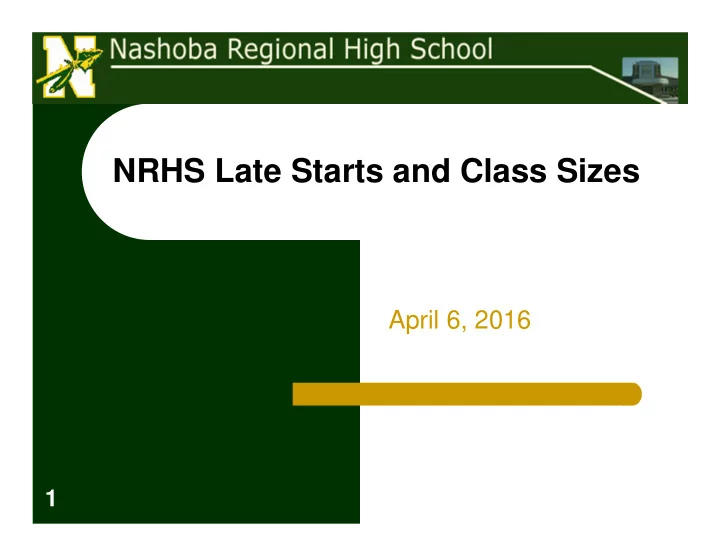

NRHS Late Starts and Class Sizes April 6, 2016 1
Late Start Key Questions How have late starts been used at NRHS this year? What has been the staff, parent, and student reaction to late starts? What is proposed for the 2016-17 year? 2
Use of late start activities Need for collaborative time was a key finding by NEASC Used for curriculum/assessment/instructional planning, for example: – Interdisciplinary literacy group w/English, SS, and Special Educators – Multiple same-course groups working on curriculum and assessment (e.g., Spanish, CP Biology, Senior English) – Interdisciplinary group working on developing alternative education programming 3
Summary of response to late starts All groups responded very positively to late starts Most common concern was lost instructional time, but only noted by a small minority of teachers and parents 4
Staff responses 2/3/16 5
Parent responses 3/3/16 6
Student responses 3/3/16 7
Student responses 3/3/16 8
Proposed for next year 12 Late Starts for collaboration 4 Late Starts for mid-terms 3 Late Starts for finals 8 Early releases Total instructional hours – 994.1 (above the required 990) 9
Instructional hours Calculations exclude passing time 153 “normal” days at 349 instructional minutes each = 53,397 minutes 8 early release days at 213* instructional minutes each = 1,704 minutes 7 mid-terms and finals late starts at 251 minutes each = 1,757 minutes 12 late starts for collaborative work at 239 minutes each = 2,868 minutes 59,688 total minutes = 994.8 hours 10
Class Size Key Questions What are high school average class sizes? How many classes have fewer than 10 students? How do classes end up with fewer than 10 students? How will the high school limit excessively small class sizes for next year? 11
2015-16 class size averages Avg. class % fewer than % 22 or more % 26 or more size 18 English 19.1 39.7% 32.4% 7.4% SS 19.4 35.2% 32.4% 11.3% Math 21.4 27.8% 51.9% 24.1% Science 20.0 29.3% 56.9% 0.0% FLD 18.2 43.6% 23.1% 7.7% 12
Classes with fewer than 10 452 total sections across the high school; 23 (5.1%) have fewer than 10 students Of those 23: – 5 are year-long core academic sections – 2 are semester-long core academic electives – 16 are semester-long electives 13
How do classes end up with fewer than 10 students? Enrollment changed from schedule build to Fall – 11 classes (48%) – Example: Ceramics 2 with 70 requests across 4 sections Newer programs/classes – 8 classes (35%) – Example: Theater Arts, Molecular Gastronomy Specialized courses/cases – 4 classes (17%) – Example: AP Latin, CP Chemistry 14
What are we doing for next year? More conservative section numbers for build, especially with electives “Many new” courses have now been in place several years; if they don’t draw enough students, they won’t be scheduled At the same time, we want to balance reasonable class sizes with maintaining specialized programs (e.g., AP Physics, AP Latin) 15
QUESTIONS? 16
Recommend
More recommend